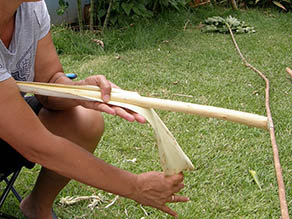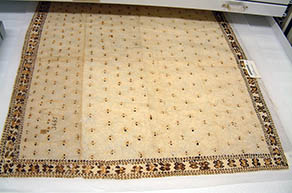 |
 |
 |
|||||
|
Kapa-making and Holism:
Leilani explains how making kapa (Hawaiian bark cloth) demonstrates how everything interconnects: “I make kapa, pounded bark. And from the very beginning—and this is significant of anything Hawaiian—in the very beginning, when we’re planting, we offer the prayer, we plant, and we take care of that plant as it grows. As it grows we also look at efficiency: we want it to grow straight as it can, and we pick the leaves along the way, leave the ones on top, so that it continues to grow and it grows without having those extra branches to have to work with. When you pound the outer bark you have to deal with that whole piece. So the less branches you have to deal with, the better. Take care of everything along the way. That’s the mālama. “And then when it’s ready, then you cut—again with prayer and thanks. Every step of the way is prayer. And then you cut the outer bark and you clean it. And as you’re doing each and every step, as I have been taught, you never bring in a negative thought. You get a negative thought, you got something else going on, so walk away from that job. Go out and cleanse at the beach, do your ho‘oponopono with somebody. Or get a good lomi. You don’t put that negative energy on the kapa. The transference of that energy is important to remain loving. “So you’re cutting off the bark. Of course you make all your tools too, and that’s a whole other process. You cut it up and you’re cleaning it, you’re pounding it, you’re offering the prayer along the way, the chant. And it takes a while: Hawaiian kapa is not just paste one on top of the other. It’s one whole piece that is felted from several pieces. And so as you continue that, and you have your good piece, then you dry it. “You’re placing whatever you need on the cloth. You’re making your own stamp materials, and making your designs that have significant meanings. If you’re making a blanket for somebody, then those will have symbols that are meaningful for that. When you scent it, you’re scenting it with particular plant like mokihana or another scented vegetation in the area, so it always has that smell with it. And when you’re done with this, then it’s offered to the person as a gift and it’s offered with much love. So that when they have it, it helps them—they feel that. It’s good mana, good energy. To me they serve as the little things that help, and a person needs any kind of help along the way. “What I wanted to really point out is the fact that everything we do is interconnected. If we’re using that kapa piece, to be laid out it has to be done with much aloha, with much love, with much good energy from the very beginning of the process. Everything we use has to be like that.”
|
|
|||||
|
Pacific Worlds > Hā‘ena, Kaua‘i > Health > External Treatments |
||||



